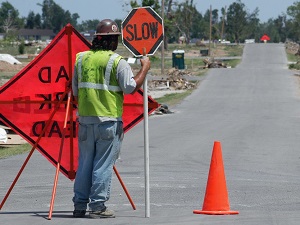It may look boring, but work zone flaggers are a critical component of work zone safety, keeping drivers, pedestrians and their crew safe and they need to be trained for that specific job.

According to the federal Department of Transportation (DOT) a work zone is an area of a highway with construction, maintenance, or utility work activities. A work zone is typically marked by signs, channelizing devices, barriers, pavement markings, and/or work vehicles. Highway, road, street, bridge, tunnel, utility, and other workers for the highway infrastructure are exposed to hazards from outside as well as from inside the work zone.
OSHA Standard 1926.200(g)(1-2) Construction areas shall be posted with legible traffic signs at points of hazard. All traffic control signs or devices used for protection of construction workers shall conform to Part VI of the MUTCD, 1988 Edition, Revision 3, or Part VI of the MUTCD, Millennium Edition, incorporated by reference in Sec. 1926.6.
For crews that are working on projects in work zones, a daily safety meeting at the start of every shift is recommended. If that is not feasible, then weekly safety meetings with every crew on the project should be held.
In addition to covering general work zone safety, the points listed below for flagger safety should be emphasized at every safety meeting.
- Certain work zones will require the use of flaggers or flag-men.
- Flaggers must be properly trained and equipped with the correct tools to perform the work.
- Flagger stations should be set up according to the traffic control requirements.
- Flagger stations should be located so that an errant vehicle has additional space to stop without entering the work space.
- The flagger should identify an escape path to use to avoid being struck by an errant vehicle.


.jpeg)
